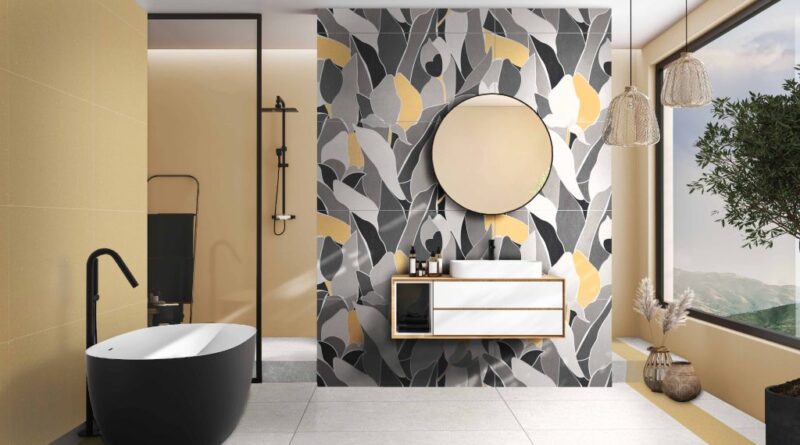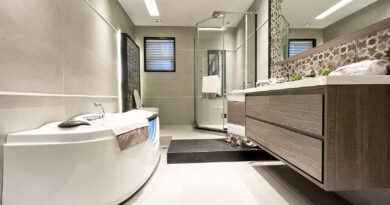Bathroom Tiles Design for Walls: How to Achieve the Perfect Look
When designing a bathroom, the tiles you choose for your walls play a crucial role in setting the tone and defining the overall aesthetic. Bathroom wall tiles not only add beauty and character to the space but also contribute to its functionality by protecting the walls from water and moisture. Achieving the perfect look with bathroom tiles requires careful consideration of style, color, texture, and layout. Here’s a guide on how to choose the right tiles for your bathroom walls and create a stunning, cohesive design that complements your vision.
Consider the Size and Layout of Your Bathroom
The size of your bathroom is one of the first factors to consider when choosing tiles. Larger bathrooms allow for a wider range of tile designs and layouts, while smaller bathrooms require more thoughtful decisions to ensure the space feels open and airy.
- For Small Bathrooms: Opt for light-colored tiles, such as whites, pastels, or soft neutrals, which help create the illusion of a larger, more open space. Glossy or reflective tiles, like ceramic or glass, can also enhance light reflection and brighten up the room.
- For Large Bathrooms: You can experiment with bold patterns, darker shades, and larger tile formats. Larger tiles, such as 12×24-inch or even bigger slabs, can help reduce grout lines and create a seamless, expansive feel.
The layout is equally important. Consider using horizontal or vertical tile placement, as these patterns can influence how the space feels. Horizontal lines create the illusion of width, while vertical lines add height to the room.
Choose the Right Tile Materials
The material of the tiles you choose will affect both the aesthetic and functionality of the bathroom. Different tile materials offer varied textures, finishes, and maintenance requirements, so it’s essential to select the one that fits your needs and style preferences.
- Ceramic and Porcelain Tiles: These materials are versatile, affordable, and come in a wide range of designs, colors, and finishes. Porcelain tiles, in particular, are dense and moisture-resistant, making them a great choice for bathroom walls. They can also mimic the look of natural stone or wood without the associated cost or maintenance.
- Glass Tiles: Glass tiles are perfect for adding a sleek, modern look to the bathroom. They reflect light beautifully and can make the space feel brighter. These tiles are also available in various colors and can be used for accent walls or borders.
- Natural Stone Tiles: Marble, granite, and travertine are luxurious options that bring a natural, timeless beauty to the bathroom. Natural stone tiles are ideal for creating a high-end look but require regular sealing and maintenance to keep them looking pristine.
Choosing the right material ensures your tiles not only look great but also stand up to the demands of bathroom environments.
Experiment with Tile Patterns and Layouts
The layout and pattern of your bathroom wall tiles can completely transform the space. Different arrangements can create various visual effects and set the overall mood of the room.
- Subway Tiles: Classic subway tiles are a popular choice for bathroom walls. They can be arranged in a traditional brick pattern or creatively in herringbone, chevron, or stacked formations. Subway tiles can complement almost any style, from modern to traditional.
- Mosaic Tiles: If you want to add intricate detail or create a feature wall, mosaic tiles are a great option. They come in small squares, giving you the flexibility to design unique patterns and textures. Mosaic tiles are often used in the shower area or as an accent around mirrors and vanities.
- Diagonal and Vertical Layouts: Diagonal and vertical patterns are ideal for creating visual interest in the bathroom. A diagonal tile pattern can make a small bathroom appear larger by drawing the eye in multiple directions. Vertical layouts can add height and create an elegant, elongated look.
- Grid and Grid-Like Layouts: If you prefer a more contemporary or minimalist look, grid layouts with evenly spaced tiles are perfect. This arrangement works well with large-format tiles and sleek, modern styles.
Choosing a tile pattern that matches your style and complements your bathroom’s size will significantly affect the space’s overall look and feel.
Consider Color and Texture
Color and texture are critical in setting the ambiance of your bathroom. The colors you choose for the wall tiles can create a serene, spa-like atmosphere or a vibrant, energetic environment.
- Neutral Tones: Neutral colors like whites, creams, grays, and beige are timeless and can create a calming, spa-like atmosphere. These shades also provide flexibility, allowing you to add colorful accessories or decor to contrast the simplicity of the tiles.
- Bold and Vibrant Colors: If you prefer a more daring design, go for rich jewel tones, deep blues, or vibrant greens. These colors can create a luxurious and dramatic effect in larger bathrooms or when used in smaller accents, such as a feature wall.
- Textured Tiles: Textured tiles, whether they mimic natural stone, have 3D patterns, or feature subtle embossing, can add depth and dimension to your bathroom walls. Textures are especially effective in creating a tactile experience and adding character to a plain space.
You can also mix and match different textures and colors to create a layered look. For example, using matte tiles on the majority of the walls and incorporating glossy tiles for a feature wall can create a beautiful contrast.
Use Tiles to Define Zones
In larger bathrooms, it’s a good idea to use tiles to define different areas, such as the shower, vanity, or bathtub zones. You can use different tiles or tile patterns to separate these spaces visually while maintaining a cohesive overall design.
- Shower Area: Consider using tiles with a textured or glossy finish in the shower area to make it more water-resistant and reflective. Mosaic tiles can add interest, while larger tiles can create a seamless, modern look.
- Accent Walls: You can highlight the space behind the bathtub or the vanity by using a different tile material or color. For instance, a bold color or patterned tile behind the bathtub can become the focal point of the room.
This zoned approach adds depth and layers to your bathroom design, making it feel more organized and dynamic.
Prioritize Durability and Maintenance
While aesthetics are important, durability and ease of maintenance are equally essential when choosing bathroom tiles. Bathroom walls are exposed to water, soap, and humidity regularly, so it’s important to select tiles that are easy to clean and won’t get damaged easily.
- Grout Choices: Opt for grout that is stain-resistant and easy to clean. Light-colored grout might require more maintenance, while darker grout can hide stains more effectively.
- Tile Sealing: Natural stone tiles and some types of ceramic tiles may require sealing to prevent water absorption and stains. Make sure to follow maintenance guidelines to keep your tiles looking fresh for years.
Conclusion
Achieving the perfect bathroom wall tile design requires a thoughtful approach that combines style, functionality, and maintenance. By considering the layout, material, color, texture, and durability of the tiles, you can create a bathroom that reflects your personality and meets your practical needs. Whether you choose classic subway tiles, luxurious marble, or contemporary mosaics, the right tiles will transform your bathroom into a beautiful and functional space that you’ll love for years to come.




